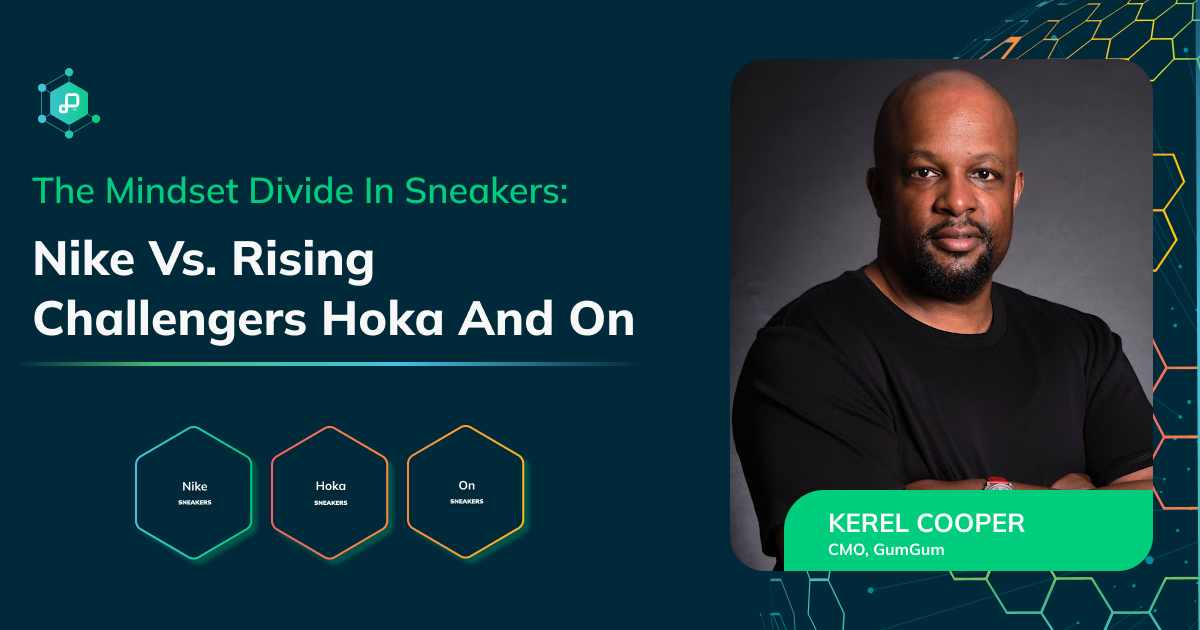Nike is bringing back one of the most iconic slogans in marketing history, “Just Do It,” with a new twist for today’s generation. The recently launched “Why Do It?” campaign reframes greatness not as a finish line but as a choice, reflecting a cultural moment where younger audiences are redefining ambition, authenticity, and participation in sport. By leaning into perseverance, Nike reminds consumers that trying, failing, and showing up are all part of the journey.
But Nike isn’t alone on the sneaker stage. Competitors like Hoka and On are rapidly reshaping the footwear landscape, carving out cultural identities that look very different from Nike’s traditional sports-first approach. Data from GumGum’s Mindset Graph, a predictive data engine that analyzes billions of content signals across text, images, video, and audio, shows how often a brand is mentioned alongside certain topics compared to an internet-wide baseline of 100. Scores above 100 mean a brand is more likely than average to appear in that context; scores below 100 mean less likely. The results reveal a bigger battle in sneakers today: sport as legacy vs. sneakers as lifestyle.

With that in mind, here’s what we found:

1. Hoka and On own “fashion-first” positioning in distinct ways
- Hoka massively over-indexes in Men’s/Women’s Shoes & Footwear (1200+) and Women’s Fashion (850+), plus niches like Foot Health. Its strength is around comfort + style.
- On spikes in Men’s Shoes & Footwear (1200), Men’s Fashion (1000+), Women’s Shoes & Footwear (800), and Fashion Trends (800). Its profile is more gender-balanced, leaning into fashion and luxury crossover.
Takeway:
Both challengers are positioned as style-driven lifestyle brands, but On leans more into fashion/luxury crossover, while Hoka leans into comfort and wellness.

2. Nike still dominates performance sports categories
- Nike over-indexes across Basketball (~500), Track & Field, College Sports, Olympics, and Gymnastics.
- By contrast, Hoka and On show minimal to no alignment with these categories — their scores in sports subcategories are negligible.
Takeway:
Nike’s cultural foundation remains tied to competition and performance, while the challengers are not seen as sport-first brands.


3. The challengers are closing cultural gaps with lifestyle relevance
- On over-indexes in Fashion Trends (~800), Style & Fashion (~450), and Street Style (~300), giving it strong alignment with aspirational lifestyle narratives.
- Hoka brings in wellness-driven niches like Foot Health (~350) and “comfort culture.”
- Nike does appear in lifestyle categories but at lower levels, suggesting it has not captured the same “fashion-first” energy.
Takeway:
Nike leads in sports heritage, but Hoka and On are carving out influence in fashion, style, and everyday culture.
The story becomes clearer when you look at where the money flows. Nike continues to invest in performance-driven campaigns, while Hoka and On are channeling budgets into lifestyle, fashion, and wellness narratives that reflect how people actually buy and wear sneakers. That shift is showing up at retail, with everyday sneaker sales driving real growth.
Sneakers are no longer confined to neat categories. Sport, style, and daily wear are converging, and advertising strategies have to move with consumers as they blur those lines.
In short, Nike’s “Why Do It?” campaign reinforces its role as the performance powerhouse, but Hoka and On are proving that the sneaker wars are not just about sport. They are about lifestyle, culture, and the contexts where people live every day. For brands, the takeaway is simple: it is not just what you sell, but the mindset you show up in.
It’s not just about where sneakers are sold, it’s about the mindsets they represent.
Nike’s new ‘Why Do It?’ campaign leans into sport, perseverance, and legacy. Our Mindset Graph shows that Nike over-indexes in sports contexts, such as basketball, five times more than the baseline audience average.
But, challengers Hoka and On are rewriting the rules. Hoka massively over-indexes in women’s fashion, at 8.5 times the baseline of 100, while On spikes in men’s fashion and footwear, with 10 and 12 times the audience baseline.
This creates a mindset divide: Nike dominates sport, while Hoka and On are winning in lifestyle and fashion. They’re the sneakers people live in, not just play in.
The lesson? Today’s sneaker wars aren’t just about sport. They’re about:
- Lifestyle
- Culture
- And how brands show up in the moments that matter
With GumGum’s Mindset Graph, we help brands tap into those cultural trends and consumer mindsets. Reach out to learn more.









